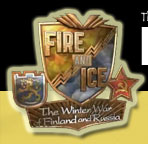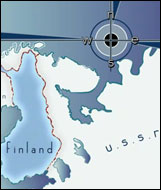

Lapland and the northern areas of Finland in the wintertime are rather close to hell on earth. As such most of the fighting here was minor as both forces had major issues in combat. Many losses were due to cold which was a greater enemy in most cases than bullets. Both the Finnish and Soviet forces knew the battles in this region would be difficult. Also of note: the Swedish volunteers came to this area on December 20th and did take part in some of this fighting. The Swedish Volunteer Corp commander was General Linder and he had also fought with the Whites in the Finnish Independence War. On the 29th of February, Linder was given total command of the Salla front including Finnish soldiers.
Petsamo
The Soviets were able to move quickly on
Petsamo mainly due to the somewhat heavy Red Army force in the
key area of Murmansk. The Finns
were not able to hold this first push and Petsamo was taken rather
quickly. Before the Finns left, they did destroy most of the harbor
equipment and materials. This attack was lead by both sea and land
by the 52nd and 104th Soviet divisions. The Finns were greatly outnumbered
in this battle as facing the Soviets was one reinforced Finnish battalion.
The main goal of the Soviets was to take Petsamo then move toward
the capitol of Finnish Lapland – Rovaniemi. There they would
link with the Soviet 88th and 122nd Divisions who had their main
thrust in the area of Salla. The Finns fought well and their delaying
actions towards Höyhen Kemijärvi stopped the Soviets by
the 18th of December. There the Soviets began to dig in as the Soviets
were already starting to have some major supply issues. The fighting
in the area was not made more pleasant by the fact the area is in
darkness for two months in this time frame. At the end of February
the Soviets once again started their advance and took Navtsi on March
7th; however, their plans to link up with the Red Army forces to
the south is a failure.

Finns
in the Lapland area during the Winter War.
Brent Snodgrass
Salla
The attack on Salla was seen by the Finns
as a much more dangerous attack than the one at Petsamo. The Soviet
plan to move their troops
south from Petsamo to link with the forces at Salla was an idea the
Finns felt was impossible. This was almost 300 miles of near wasteland
the Soviets would have to move through and the Finns felt this task
would be too great for the Red Army to accomplish. The Finns felt
those Soviet soldiers in the north were stuck outside of Petsamo
and no real threat in other sections. The attacks at Salla however
were a more dangerous threat. The attack was lead by the 122nd and
88th Soviet Divisions. The Finns countered this with the 40th Infantry
Regiment. The Soviets wanted to move to Kemijärvi then move
quickly to Rovaniemi. After linking up with the forces from Petsamo
the Soviets would then move west to take the town of Tornio. The
Soviets took the town of Salla on December 8th and by December 9th
they had moved into a key crossroad region that would threaten Kemijärvi.
By the 16th the Soviets had moved into two key positions: Pelkosenniemi
(north of Kemijärvi) as well as Joutsjärvi (to the east
of Kemijärvi). This meant the town was caught between two forces
and might be taken. The Finns were able to launch a counterattack
against the Soviets starting the night of the 17th and scored a great
victory at Pelkosenniemi. This allowed the Finns to concentrate on
the larger Soviet force at Joutsjärvi. The Soviet force in this
area were already a bit haggard as their losses, while attacking
the Finnish lines defending Kemijärvi, had been severe. In one
attack they lost almost 600 men. The Finns then launched another
attack on January 2nd forcing the Soviets back to Märkäjärvi.
The Soviets once again dug in and this line stayed stable to the
end of the War.





